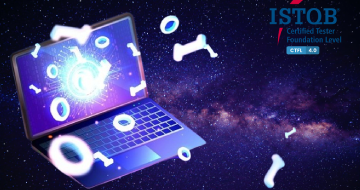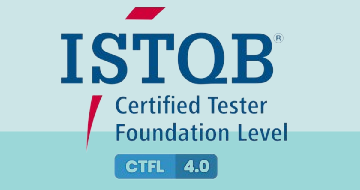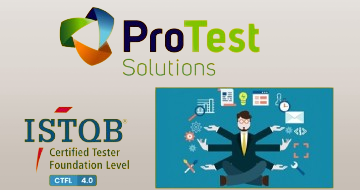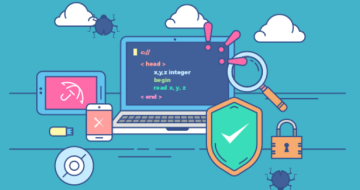IIRF Online > Development > Software Testing > ISTQB Certified Tester Foundation Level (CTFL) > ISTQB Foundation Level preparation course+1000quiz examples
ISTQB Foundation Level preparation course+1000quiz examples by Udemy
The easiest preparation for certification ISTQB Certified Tester Foundation Level (CTFL) 2018 v3.1 and 2023 v4.0 [NEW!]
Course Highlights
- Successfully prepare and pass the ISTQB Certified Tester Foundation Level (CTFL) version 2023 v4.0 [NEW!]
- Successfully prepare and pass the ISTQB Certified Tester Foundation Level (CTFL) version2018 v3.1 [Retiring]
- Links to relevant study materials for the istqb certification
- Hundreds of questions similar to those that will be on the istqb foundation level real exam
- Questions are distributed by chapters and sections/paragraphs for the best learning experience
- 5+ exam samples, for training before the real istqb exam
- All necessary information about istqb foundation level Exam Structure and Rules
- All necessary information about How to take the isqtb exam online at home
- Preparation will take a couple of weeks
- An easy and clear way to prepare for the exam, without 20 hours of video or outdated information
Skills you will learn!
Curriculum
3 Topics
ISTQB (CTFL) exam preparation course intro v4.0 [NEW!] vs v3.1 [Retiring]
v4.0 [NEW!] vs v3.1 [Retiring] - Practical advise
v4.0 [NEW!] vs v3.1 [Retiring] - In details
7 Topics
Overview of the V4.0 [NEW!] ISTQB Certified Tester Foundation Level (CTFL)
Why ISTQB® CTFL Certification
Contents of ISTQB® CTFL v4.0
A simple approach for ISTQB CTFL exam preparation
A simple approach for ISTQB CTFL exam preparation
Study materials for V4.0 [NEW!] ISTQB Foundation level exam preparation
Study materials for V4.0 [NEW!] ISTQB Foundation level exam preparation
9 Topics
Chapter 1. Fundamentals of Testing - Intro
Chapter 1. Fundamentals of Testing - Home Assignment
What does "K" mean? (Learning Objectives/Cognitive Level of Knowledge)
1.0 Keywords
1.0 Keywords
1.1. What is Testing?
1.1.1. Test Objectives
1.1.2. Testing and Debugging
1.1 What is Testing?
5 Topics
1.2. Why is Testing Necessary?
1.2.1. Testing’s Contributions to Success
1.2.2. Testing and Quality Assurance (QA)
1.2.3. Errors Defects Failures and Root Causes
1.2 Why is Testing Necessary?
10 Topics
1.3. Testing Principles
1.3. Testing Principles
1.3. Testing Principles I -Testing shows the presence not the absence of defects
1.3 Testing Principles II - Exhaustive testing is impossible
1.3 Testing Principles III - Early testing saves time and money
1.3. Testing Principles IV - Defects cluster together
1.3. Testing Principles V - Tests wear out (Beware of the pesticide paradox)
1.3. Testing Principles VI - Testing is context dependent
1.3. Testing Principles VII - Absence-of-defects fallacy
1.3 Testing Principles
7 Topics
1.4. Test Activities Testware and Test Roles
1.4.1. Test Activities and Tasks
1.4.2. Test Process in Context
1.4.3. Testware
1.4.4. Traceability between the Test Basis and Testware
1.4.5. Roles in Testing
1.4 Test Activities Testware and Test Roles
5 Topics
1.5 Essential Skills and Good Practices in Testing
1.5.1. Generic Skills Required for Testing
1.5.2. Whole Team Approach
1.5.3. Independence of Testing
1.5 Essential Skills and Good Practices in Testing
9 Topics
Chapter 2. Testing Throughout the SDLC - Intro
Chapter 2. Testing Throughout the SDLC - Home Assignment
2.0 Keywords
2.1. Testing in the Context of a SDLC
2.1. Testing in the Context of a SDLC
2.2. Test Levels and Test Types
2.2. Test Levels and Test Types
2.3. Maintenance Testing
2.3. Maintenance Testing
7 Topics
Chapter 3. Static Testing - Into
Chapter 3. Static Testing - Home Assignment
3.0 Keywords
3.1. Static Testing Basics
3.1. Static Testing Basics
3.2. Feedback and Review Process
3.2. Feedback and Review Process
4 Topics
Chapter 4. Test Analysis and Design - Intro
Chapter 4. Test Analysis and Design - Home Assignment
4.0 Keywords
4.1. Test Techniques Overview
34 Topics
4.2. Black-Box Test Techniques
4.2.1. Equivalence Partitioning I - The simplest Numeric EP
4.2.1. Equivalence Partitioning II - The simplest Non-numeric EP
4.2.1. Equivalence Partitioning V - Complication of Non-numeric EP
4.2.1. Equivalence Partitioning IV - Multiple sets of partitions
4.2.1. Equivalence Partitioning V - Complication of Multiple sets of EP
4.2.1. Equivalence Partitioning VI - ISTQB Sample Exam A
4.2.1. Equivalence Partitioning VII - ISTQB Sample Exam B
4.2.1. Equivalence Partitioning VIII - ISTQB Sample Exam C
4.2.1. Equivalence Partitioning IX - ISTQB Sample Exam D
4.2.2. Boundary Value Analysis I - The common misunderstanding of BVA
4.2.2 Boundary Value Analysis II -The correct explanation of 2-value BVA
4.2.2 Boundary Value Analysis III - The correct explanation of 3-value BVA
4.2.2 Boundary Value Analysis IV - ISTQB Sample Exam B
4.2.2 Boundary Value Analysis V - ISTQB Sample Exam A
4.2.2 Boundary Value Analysis VI - ISTQB Sample Exam D
4.2.3. Decision Table Testing I - How to build and simplify the Full DT
4.2.3. Decision Table Testing II - How to build and simplify the Full DT
4.2.3. Decision Table Testing III - ISTQB Sample Exam A
4.2.3. Decision Table Testing IV - ISTQB Sample Exam B
4.2.3. Decision Table Testing V - ISTQB Sample Exam C
4.2.4. State Transition Testing I - Simple State Transition Diagram
4.2.4. State Transition Testing II - State Table and All Transitions coverage
4.2.4. State Transition Testing III - Guard condition and actions(Sample Exam B)
4.2.4. State Transition Testing IV - ISTQB Sample Exam A
4.2.4. State Transition Testing V - ISTQB Sample Exam D
4.2 Likes and feedbacks
4.2. Black-Box Test Techniques (Syllabus stheory simplified)
4.2. Black-Box Test Techniques - Quiz I
4.2. Black-Box Test Techniques - Quiz II
4.2. Black-Box Test Techniques - Quiz III
4.2. Black-Box Test Techniques - Quiz IV
4.2. Black-Box Test Techniques - Quiz V
4.2. Black-Box Test Techniques - Quiz VI
2 Topics
4.3. White-Box Test Techniques
4.3. White-Box Test Techniques
2 Topics
4.4. Experience-based Test Techniques
4.4. Experience-based Test Techniques
2 Topics
4.5. Collaboration-based Test Approaches
4.5. Collaboration-based Test Approaches
11 Topics
Chapter 5. Managing the Test Activities - Intro
Chapter 5. Managing the Test Activities - Home Assignment
5.0 Keywords
5.1. Test Planning
5.1. Test Planning
5.2. Risk Management
5.2. Risk Management
5.3. Test Monitoring Test Control and Test Completion
5.3. Test Monitoring Test Control and Test Completion
5.4. Configuration Management & 5.5. Defect Management
5.4. Configuration Management & 5.5. Defect Management
7 Topics
Chapter 6. Test Tools - Intro
Chapter 6. Test Tools - Home Assignment
6.0 Keywords
6.1. Tool Support for Testing
6.1. Tool Support for Testing
6.2. Benefits and Risks of Test Automation
6.2. Benefits and Risks of Test Automation
17 Topics
v4.0 [NEW!] Exam Structure and Rules
v4.0 [NEW!] Exam Structure and Rules
Where to register for the online exam and what does the exam look like?
Where to register for the online exam and what does the exam look like?
Tips and tricks for the exam
Congratulations!!!
Exam Sample A (ISTQB CTFL v4.0 Sample Exam A Questions v1.1)
Exam Sample B (ISTQB CTFL v4.0 Sample Exam B Questions v1.0)
Exam Sample C (ISTQB CTFL v4.0 Sample Exam C Questions v1.0)
Exam Sample D (ISTQB CTFL v4.0 Sample Exam D Questions v1.0)
Exam Sample E
Exam Sample F
Exam Sample G
Exam Sample H
Exam Sample I
Sample Exam from ASTQB (ISTQB CTFL 4.0 - Sample Exam 3)
Sample Exam from ASTQB (ISTQB CTFL 4.0 - Sample Exam 4)
4 Topics
Introduction. What is ISTQB foundation level
Course introduction
Syllabus vs book what to choose
How I passed ISTQB Foundation Level Certification in 2020
13 Topics
Chapter 1. Fundamentals of Testing
Home assignment
1.1 What is Testing?
1.1 What is Testing?
1.2 Why is Testing Necessary
1.2 Why is Testing Necessary
1.3 Seven Testing Principles
1.3 Seven Testing Principles
1.4 Test Process
1.4 Test Process. Quiz 1
1.4 Test Process. Quiz 2
1.5 The Psychology of Testing
1.5 The Psychology of Testing
12 Topics
Chapter 2. Testing throughout the software life cycle
Home assignment
2.1 Software Development Lifecycle Models
2.1 Software Development Lifecycle Models
2.2 Test Levels
2.2 Test Levels. Quiz 1
2.2 Test Levels. Quiz 2
2.3 Test Types
2.3 Test Types. Quiz 1
2.3 Test Types. Quiz 2
2.4 Maintenance Testing
2.4 Maintenance Testing
7 Topics
Chapter 3. Static Testing
Home assignment
3.1 Static Testing Basics
3.1 Static Testing Basics
3.2 Review Process
3.2 Review Process. Quiz 1
3.2 Review Process. Quiz 2
16 Topics
Chapter 4. Test Techniques
Home assignment
4.1 Categories of Test Techniques
4.1 Categories of Test Techniques
4.2 Equivalence Partitioning
4.2 Boundary Value Analysis
4.2 Decision Table Testing
4.2 State transition testing
4.2 Likes and feedbacks
4.2 Black-box Test Techniques
4.2 Black-box Test Techniques. Quiz 1
4.2 Black-box Test Techniques. Quiz 2
4.3 White-box Test Techniques
4.3 White-box Test Techniques
4.4 Experience-based Test Techniques
4.4 Experience-based Test Techniques
15 Topics
Chapter 5. Test Management
Home assignment
5.1 Test Organization
5.1 Test Organization
5.2 Test Planning and Estimation
5.2 Test Planning and Estimation. Quiz 1
5.2 Test Planning and Estimation. Quiz 2
5.3 Test Monitoring and Control
5.3 Test Monitoring and Control
5.4 Configuration Management
5.4 Configuration Management
5.5 Risks and Testing
5.5 Risks and Testing
5.6 Defect Management
5.6 Defect Management
6 Topics
Chapter 6. Tool Support for Testing
Home assignment
6.1 Test Tool Considerations
6.1 Test Tool Considerations
6.2 Effective Use of Tools
6.2 Effective Use of Tools
11 Topics
Lesson 7. Exam Structure and Rules
How to know if you're ready for the exam
Lesson 7. Exam Sample A
Lesson 7. Exam Sample B
Lesson 7. Exam Sample C
Lesson 7. Exam Sample D
Lesson 7. Exam Sample E
Lesson 7. Exam Sample F
Lesson 7. Exam Sample G
Congratulations!!! Register for the exam
Register for the exam
1 Topic
Bonus lecture

ISTQB Foundation Level preparation course+1000quiz examples




